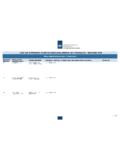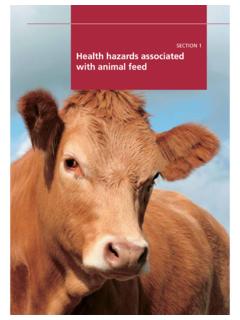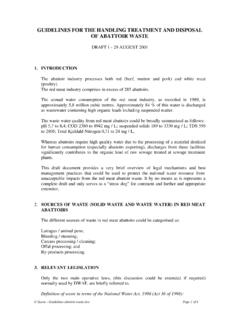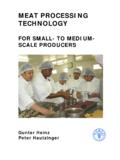Transcription of AN OVERVIEW OF THE RENDERING INDUSTRY
1 1AN OVERVIEW OF THE RENDERING INDUSTRY David L. Meeker, , MBA National Renderers Association C. R. Hamilton, Darling International, Inc. Summary One-third to one-half of each animal produced for meat, milk, eggs, and fiber is not consumed by humans. These raw materials are subjected to RENDERING processes resulting in many useful products. Meat and bone meal, meat meal, poultry meal, hydrolyzed feather meal, blood meal, fish meal, and animal fats are the primary products resulting from the RENDERING process. The most important and valuable use for these animal by-products is as feed ingredients for livestock, poultry, aquaculture, and companion animals.
2 There are volumes of scientific references validating the nutritional qualities of these products, and there are no scientific reasons for altering the practice of feeding rendered products to animals. Government agencies regulate the processing of food and feed, and the RENDERING INDUSTRY is scrutinized often. In addition, INDUSTRY programs include the use of good manufacturing practices, hazard analysis and critical control point (HACCP), codes of practice, and third-party certification. The Food and Drug Administration (FDA) regulates animal feeds and prohibits certain ruminant proteins from being used in ruminant diets to prevent the spread of bovine spongiform encephalopathy (BSE).
3 Though often frustrated by the attention it receives, the RENDERING INDUSTRY clearly understands its role in the safe and nutritious production of animal feed ingredients and has done it very effectively for over 100 years. The availability of rendered products for animal feeds in the future depends on regulation and the market. Renderers are innovative and competitive and will adapt to changes in both. Regulatory agencies will determine whether certain raw materials can be used for animal feed. The National Renderers Association (NRA) supports the use of science as the basis for regulation while aesthetics, product specifications, and quality differences should be left to the marketplace.
4 Customer expectations, consumer demand, and economic considerations will dictate product specifications and prices. Without the continuing efforts of the RENDERING INDUSTRY , the accumulation of unprocessed animal by-products would impede the meat industries and pose a serious potential hazard to animal and human health. Raw Material A by- product is defined as a secondary product obtained during the manufacture of a principal commodity. A co- product is a product that is usually manufactured together or sequentially with another item because of product or process similarities. Some prefer the more positive connotation of the term co- product , but for simplicity, this book will mostly use the term by- product .
5 A Essential RENDERING OVERVIEW Meeker and Hamilton 2portion of the profit returned to animal production and processing industries depends on the utilization of the by-products or co-products ancillary to the production of meat, milk, and eggs for human food production. The FDA regulates which materials can be included in animal feed, and in 1997 banned the feeding of ruminant materials back to ruminant animals. Considerable debate has taken place recently on whether more bovine materials should be banned from all animal feeds. The approximately 300 RENDERING facilities in North America serve animal industries by utilizing the by-products which amount to more than half of the total volume produced by animal agriculture.
6 The United States currently produces, slaughters, and processes approximately 100 million hogs, 35 million cattle, and eight billion chickens annually. By-products include hides, skins, hair, feathers, hoofs, horns, feet, heads, bones, toe nails, blood, organs, glands, intestines, muscle and fat tissues, shells, and whole carcasses. These by- product materials have been utilized for centuries for many significant uses. The products produced from the inedible (meaning not consumed by humans) raw material make important economic contributions to their allied industries and society. In addition, the RENDERING process and utilization of these by-products contribute to improvements in environmental quality, animal health, and public health.
7 Approximately 49 percent of the live weight of cattle, 44 percent of the live weight of pigs, 37 percent of the live weight of broilers, and 57 percent of the live weight of most fish species are materials not consumed by humans. Some modern trends, such as pre-packed/table ready meat products, are increasing the raw material quantities for RENDERING . The current volume of raw material generated in the United States is nearly 54 billion pounds annually with another 5 billion pounds generated in Canada. Raw materials vary, but an overall approximation of content would be 60 percent water, 20 percent protein and mineral, and 20 percent fat before the RENDERING process.
8 These organic materials are highly perishable and laden with microorganisms, many of which are pathogenic to both humans and animals. RENDERING offers a safe and integrated system of animal raw material handling and processing that complies with all of the fundamental requirements of environmental quality and disease control. The RENDERING Process RENDERING is a process of both physical and chemical transformation using a variety of equipment and processes. All of the RENDERING processes involve the application of heat, the extraction of moisture, and the separation of fat. The methods to accomplish this are schematically illustrated in Figure 1 (Hamilton, 2004).
9 The processes and equipment are described in detail in the chapter in this book on operations. The temperature and length of time of the cooking process are critical and are the primary determinant of the quality of the finished product . The processes vary according to the raw material composition. All RENDERING system technologies include the collection and sanitary transport of raw material to a facility where it is ground into a consistent particle size and conveyed to a cooking vessel, either Essential RENDERING OVERVIEW Meeker and Hamilton 3continuous-flow or batch configuration. Cooking is generally accomplished with steam at temperatures of 240 to 290 F (approximately 115 to 145 C) for 40 to 90 minutes depending upon the type of system and materials.
10 Most North American RENDERING systems are continuous-flow units. Regardless of the type of cooking, the melted fat is separated from the protein and bone solids and a large portion of the moisture is removed. Most importantly, cooking inactivates bacteria, viruses, protozoa, and parasites. Alternative methods of raw material disposal such as burial, composting, or landfill applications do not routinely achieve inactivation of microorganisms. Fat is separated from the cooked material via a screw press within a closed vessel. Following the cooking and fat separation, the cracklings or crax, which includes protein, minerals, and some residual fat, are then further processed by additional moisture removal and grinding, then transferred for storage or shipment.











